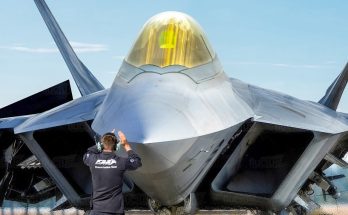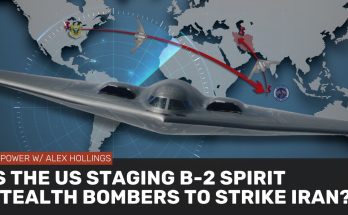The FA-18 Hornet family has long been one of the U.S. Navy’s most trusted multirole fighters, serving in both offensive and defensive capacities. But as new, highly capable threats emerge, particularly from advanced stealth aircraft like China’s J-20, the FA-18’s role in modern warfare is evolving. The FA-18’s new electronic warfare (EW) system could represent a significant shift in its capability, giving it the tools to counter advanced adversaries, including stealth fighters like the J-20.
The FA-18’s New Electronic Warfare System
The FA-18 has traditionally been a versatile, multi-mission aircraft, but in recent years, the focus has been on adapting its capabilities to meet the challenges posed by newer threats, especially stealth aircraft and advanced radar systems. One of the key upgrades is the development and integration of a new Electronic Warfare (EW) system designed to counter these emerging threats.
This new system, which has been tested and integrated into the FA-18E/F Super Hornet variant, includes advanced capabilities such as jamming, radar deception, and anti-radiation measures. Specifically, it features the Next Generation Jammer (NGJ), a system developed by Raytheon that enhances the aircraft’s ability to disrupt enemy radar and communication systems, essentially making it a stealth killer in the realm of electronic warfare.
How the FA-18’s New EW System Could Challenge China’s J-20
The J-20 Mighty Dragon, China’s most advanced fifth-generation fighter, is designed to be a stealth aircraft with advanced sensor fusion and long-range capabilities, built to compete with the likes of the U.S. F-22 Raptor and F-35 Lightning II. The J-20’s stealth features allow it to evade detection by radar and engage targets from extended ranges, making it a significant threat in contested airspace.
However, stealth is not invincible — and that’s where the FA-18’s new EW system comes into play. Here are the key ways the FA-18’s EW system could counter China’s J-20:
-
Disrupting Stealth Sensors: Stealth aircraft, including the J-20, are designed to minimize their radar cross-section (RCS) to evade detection. However, stealth technology is vulnerable to certain types of electromagnetic and radar threats, especially those that target the aircraft’s sensor systems rather than relying solely on radar detection. The NGJ can jam or confuse radar signals, making it harder for the J-20’s sensors to effectively track and engage targets. By targeting electromagnetic emissions (such as radar and communication systems), the FA-18 can degrade the J-20’s ability to maintain situational awareness.
-
Anti-Radiation and Anti-Jamming Capabilities: One of the major threats to stealth aircraft is the ability of adversary aircraft to use anti-radiation missiles (ARMs) to track and destroy radar or communication systems. The FA-18’s EW system can not only disrupt the enemy radar systems but can also counter jamming efforts by actively deceiving the enemy’s sensors. This would help FA-18s and other U.S. aircraft to identify and engage the J-20, even if it tries to cloak itself using its stealthy profile or by jamming radar.
-
Electronic Attack Roles: The FA-18 Super Hornet is capable of operating in a dedicated electronic attack role. In this capacity, it can use its advanced jamming systems to degrade the enemy’s air defense networks or disrupt command-and-control systems that would coordinate attacks against friendly forces. By neutralizing or confusing the radar and communication systems that are typically used by the J-20 and other Chinese aircraft, the FA-18 could help maintain air superiority, even against a highly advanced stealth fighter.
-
Suppression of Enemy Air Defenses (SEAD): The FA-18’s EW capabilities also play a critical role in SEAD missions. During these operations, the goal is to neutralize or destroy the enemy’s surface-to-air missile (SAM) systems and air defense radars, clearing the way for other U.S. aircraft (including stealth bombers and fighters) to operate freely. The J-20, despite its stealth features, would likely operate within a dense air defense environment where radar jamming and EW operations can significantly degrade its effectiveness. By disrupting these air defense systems, the FA-18’s EW systems provide vital support for U.S. operations in contested airspaces.
-
Combatting Sensor Fusion: Sensor fusion refers to the process by which an aircraft integrates information from multiple radar and sensor sources to create a complete and real-time picture of the battlefield. The J-20’s advanced sensor fusion allows it to detect and track multiple targets at long ranges. However, advanced jamming techniques from the FA-18’s EW suite could disrupt this sensor fusion, causing confusion and reducing the J-20’s situational awareness. A degraded or confused sensor system would render the J-20 less effective at engaging or evading threats.
The Advantage of the FA-18 Super Hornet in Electronic Warfare
The FA-18E/F Super Hornet has long been the U.S. Navy’s workhorse fighter, but the addition of cutting-edge EW capabilities brings it into a new era of combat effectiveness. The Next Generation Jammer is a particularly important upgrade, offering advanced electromagnetic spectrum warfare capabilities to counter stealth and other modern threats. The combination of this new EW system, along with the Super Hornet’s versatility, makes it a valuable tool in anti-stealth operations.
Additionally, the FA-18’s adaptability is crucial. As a multirole fighter, it can engage in a wide range of missions — from close air support and air-to-air combat to electronic attack and strike missions. This adaptability ensures the FA-18 can not only disrupt and degrade the effectiveness of advanced threats like the J-20, but also deliver a variety of munitions against ground targets and air defense systems.
Challenges to Overcome
While the FA-18’s EW capabilities provide a critical advantage, there are still challenges to consider. The J-20’s stealth features and advanced radar systems are continuously improving, and it’s likely that China will continue to enhance its fifth-generation fighters in response to new U.S. capabilities. Additionally, while the FA-18 Super Hornet is a formidable platform, it is still a fourth-generation aircraft, and in some situations, it might struggle against fifth-generation fighters like the J-20 in a head-to-head confrontation, particularly when facing off against the J-20 in stealth mode or beyond visual range.
However, the new EW systems integrated into the FA-18 give it an important tool to level the playing field in contested environments. By neutralizing the J-20’s technological advantages, the FA-18 can help ensure that the U.S. maintains an edge in high-stakes air-to-air combat.
Conclusion: Stealth Killer?
The FA-18’s new Electronic Warfare system is indeed a game-changer in the way it can counter stealth aircraft, including China’s J-20. While the J-20’s advanced stealth and sensor fusion make it a formidable adversary, the FA-18’s EW capabilities offer a way to disrupt and degrade these features, neutralizing some of the J-20’s advantages in a highly contested combat environment.
In essence, while the FA-18 Super Hornet may not have the stealth of the J-20, its ability to outwit and counter advanced radar systems and jamming efforts could make it a key asset in modern warfare. When combined with its multirole versatility, it’s an aircraft that remains highly capable of taking on even the most advanced adversaries in the skies.



